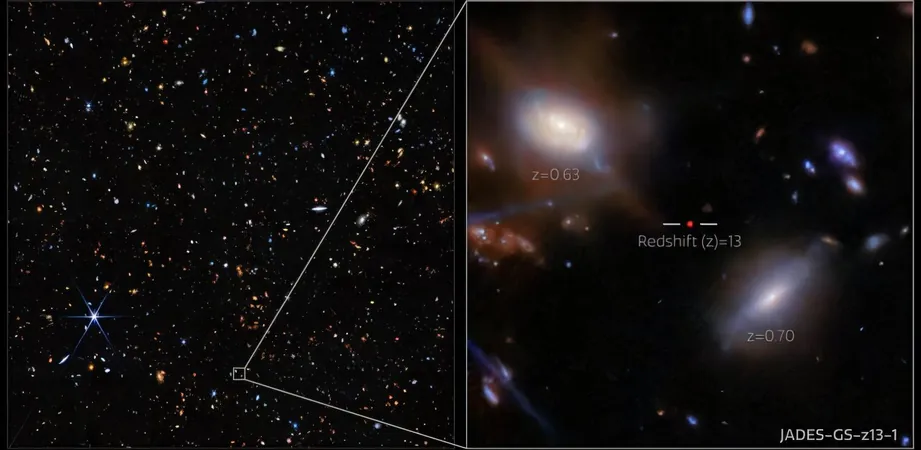
Astonishing Discovery: Webb Telescope Unveils Galaxy Cutting Through Fog of the Early Universe!
2025-03-26
Author: Ting
Groundbreaking Discovery
Astronomers have made a groundbreaking discovery that challenges our understanding of the cosmos. Utilizing the advanced capabilities of the NASA/ESA/CSA James Webb Space Telescope, scientists have detected bright hydrogen emissions from a galaxy dating back to an astonishingly early period in the universe—just 330 million years after the Big Bang. This revelation confronts the long-held belief that galaxies of that era were engulfed in a thick fog of neutral hydrogen that obscured their light.
Analysis of JADES-GS-z13-1
A group of researchers examined a galaxy named JADES-GS-z13-1, employing the telescope's impressive NIRCam imaging technology and subsequent observations with the Near-Infrared Spectrograph (NIRSpec). Their initial analysis rendered a redshift estimate of 12.9, which was later confirmed to be 13.0—a strong indication of its immense distance from Earth in cosmic terms.
Surprising Emission Detection
One of the most surprising elements of this discovery was the detection of a bright wavelength of light, specifically the Lyman-α emission attributed to hydrogen atoms. This emission was unexpectedly intense for a galaxy so early in the universe's development. Professor Roberto Maiolino from Cambridge's Kavli Institute for Cosmology noted that during this epoch, the universe was shrouded in a thick fog of neutral hydrogen that typically prevented energetic ultraviolet light from escaping.
Implications for Galaxy Formation
The majority of galaxies during this time were encapsulated in this hydrogen haze, making it impossible for their light, including Lyman-α emissions, to break through until the process of reionization occurred—a phenomenon believed to have taken place around one billion years after the Big Bang. However, the clarity of the emission from GS-z13-1 has taken astronomers by surprise, forcing them to reevaluate existing models of galaxy formation.
Expert Insights
Kevin Hainline from the University of Arizona remarked, “Finding a galaxy like this at such an early stage is like spotting a lighthouse through a dense fog—unexpected and remarkable.” He emphasized the implications of this discovery on our comprehension of the early universe's evolution.
Future Observations
The precise source of the Lyman-α radiation remains uncertain but may point to the universe's first stars—more massive, hotter, and luminous than typical stars that formed later. Another possibility could involve a powerful active galactic nucleus fueled by one of the earliest supermassive black holes, further enriching our understanding of astrophysical processes during the dawn of galaxies.
Conclusion
As scientists plan to conduct follow-up observations of GS-z13-1, they eagerly anticipate uncovering more secrets of this intriguing galaxy. Each new piece of data holds the potential to reshape our view of the cosmos and illuminate previously uncharted territories in our understanding of the universe's infancy.
This extraordinary find not only challenges existing theories but may also herald a new era in cosmology, capturing the attention of researchers and enthusiasts alike. Stay tuned for the latest updates on this captivating astronomical journey!


 Brasil (PT)
Brasil (PT)
 Canada (EN)
Canada (EN)
 Chile (ES)
Chile (ES)
 Česko (CS)
Česko (CS)
 대한민국 (KO)
대한민국 (KO)
 España (ES)
España (ES)
 France (FR)
France (FR)
 Hong Kong (EN)
Hong Kong (EN)
 Italia (IT)
Italia (IT)
 日本 (JA)
日本 (JA)
 Magyarország (HU)
Magyarország (HU)
 Norge (NO)
Norge (NO)
 Polska (PL)
Polska (PL)
 Schweiz (DE)
Schweiz (DE)
 Singapore (EN)
Singapore (EN)
 Sverige (SV)
Sverige (SV)
 Suomi (FI)
Suomi (FI)
 Türkiye (TR)
Türkiye (TR)
 الإمارات العربية المتحدة (AR)
الإمارات العربية المتحدة (AR)